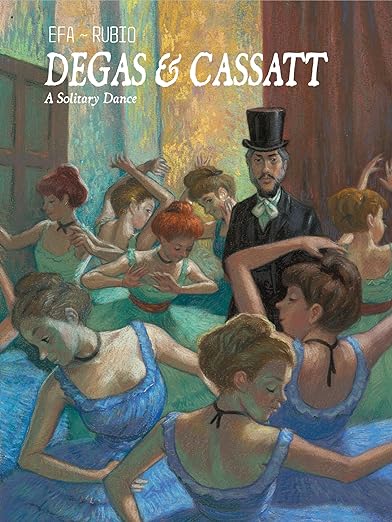
By EFA & Rubio, translated by Edward Gauvin (NBM)
ISBN: 978-1-68112-324-0 (Album HB) eISBN: 978-1-68112-325-7
NBM’s line of graphic biographies never fails to delight, and this oversized luxury hardcover (also available digitally) is one of the most fascinating thus far: exploring one of painting’s greatest yet least understood masters and – deducing by inference – one of the most occluded, protracted and certainly frustrated romances in history…
Degas & Cassatt: A Solitary Dance reunites award-winning screenwriter, historian and novelist Salva Rubio (Max, The Photographer of Mauthausen) with animator/illustrator Ricard Fenandez AKA “Efa” (Les Icariades, Rodriguez, Le Soldat, L’Ãme du Vin: L’ail et l’huile). Their previous collaborations are also beautiful biographies – Monet: Itinerant of Light and Django, Hand on Fire: The Great Django Reinhardt.
First released in France, the translated Degas: La danse de la solitude is preceded by mood-setting quotes from Baudelaire and Shakespeare and closes with a detailed Bibliography of suggestions for further study and appreciation. Between those points is a compelling exploration of one of the most turbulent periods in European and Art history, as impacted upon and partially shaped by a controversial, conflicted, contradictory and misunderstood master of line, colour and form…
This pictorial conjecture gently deconstructs enigmatic Edgar Degas is rendered by EFA in the manner of the pastel crayon drawings so beloved and powerfully utilised by Hilaire-Germain-Edgar De Gas (July 19th 1834 – September 27th 1917). It affords a mistily miasmic uncertainty which never obscures detail whilst shaping a mystery to confound and unsettle readers. The stunning confection of painterly images traces – via flashback and supposition – the life of a troubled artistic genius raised almost completely by male relatives to covet success, scorn women and criticise himself mercilessly.
In Paris during the 1870s, a graciously-barbed, polite war of wills and conception began. The creative world was formalised and controlled by a hidebound elite – “The Salon” – dictating what could and could not be ART. The convention-constricted organisation even dictated form, method and content until that stultifying impasse was challenged by a haphazard band of free thinkers who would become derisively dubbed “The Impressionists”.
Among their most outspoken and headstrong proponents were Manet, Monet, Cezanne, Renoir, Berthe Morisot, Sisley, Bazille and others, but they only really started making waves once staid, bellicose and unfathomable Degas began associating with them. He bemused and bewildered his fellow outriders and the Bohemian set they congregated with, but never felt himself part of the group… or any human affiliation.
His story is seen from its conclusion as ‘1: Solitude’ opens on Saturday, 29th September 1917 with an elderly lady staring at a crypt in the Montmartre Cemetery in Paris. She is American painter Mary Cassatt who probably knew Degas better than any other person. On visiting his empty studio, sentiment swallows her as she opens his abandoned notebooks, thinks back and wonders…
In ‘2: Monsieur Degas’ the odd bourgeois’ formative days are selectively reviewed and his misanthropic, misogynistic, chauvinistic and racist stances are quizzed through his problems with his own output. Degas’ work does not and has never satisfied him and he can only find inspiration in places no decent person belongs. It seems the austere bookish elitist cannot open up to his peers but is addicted to being an anonymous, masked and untouchable patron of brothels, bawdy houses and ballet… where only the most degraded – or poverty stricken – go.
As his renown grows a meeting with an art dealer from the USA leads to a possibility of a different life in ‘3: Miss Cassatt’, but the voluntary hermit’s true genius appears to be self-sabotage. Even as the impressionists gradually destroy the influence of The Salon, Degas finally starts generating work worthy of his talent whilst sinking deeper into isolation and pushing away all those who could be friends… or perhaps more…
The story ends with ‘4: The Dance’, allowing some fanciful elaboration on the biographers’ part as the elderly artist confronts his muse and inhibitions in a kind of Happy Ever After that concludes with Rubio’s prose rumination ‘Did Monsieur Degas ever find peace?’
Enchanting, thought-provoking and supremely enthralling, Degas & Cassatt: A Solitary Dance is a soft-focus voyage of illicit discovery no lover of unforgettable pictures can be without.
© EFA/RUBIO/ ÉDITIONS DU LOMBARD (DARGAUD- LOMBARD S.A.) 2021. All rights reserved.
Degas & Cassatt: A Solitary Dance will be published on March 12th 2024 and is available for pre-order. For more information and other great reads see http://www.nbmpub.com/
